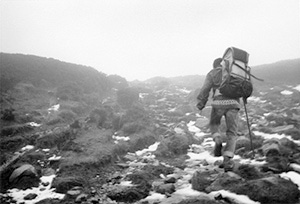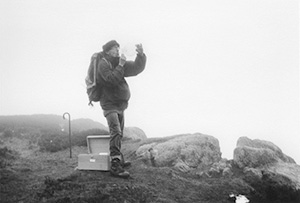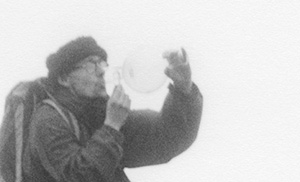| Cloud Walk 3 Schiehallion, Scottish Highlands, 18.12.1997 |
|||
|
Gerhard Lang has coined a specific word for a particular area of his research into landscape aesthetics: nubeology. It involves the study of an extremely elusive, transient and mobile part of the landscape: the natural phenomenon of clouds. The Cloud Walks represent a special method of a nubeological approach to the clouds in the sky. By Stephen Bann [...] The young German artist Gerhard Lang became known to me when I acted as his advisor on a postgraduate dissertation at the Slade School of Art in London. This dissertation covered Constable’s Cloud Studies, and the related meteorological material in Luke Howard’s Climate of London, both of which emerged around 1820. The “Cloud Walks” that Lang undertook in the late 1990s emerged out of this research into the experimental nature of Constable’s studies, and their relationship to the tradition of natural philosophy. As a German artist, coming from a background of Green politics and the political happening (aktion) of the late 1960s, this represented for him a congenial, if historically remote, foyer of research. However, the way in which he began to design his own artistic experiments bore clear parallels to a more recent manifestation of the English preoccupation with landscape. He adopted the new generic landscape form of the “walk”, which had been developed by Richard Long and Hamish Fulton, the two major British practitioners of “Land Art”, and also by his Swiss mentor, Lucius Burckhardt. [...] [Excerpt from: The Artist’s Brief, in: Ways Around Modernism. Theories of Modernism and Postmodernism in the Visual Arts, by Stephen Bann, Volume 2; Routledge, New York and London, 2007. More about Stephen Bann: see Glossary] Gerhard Lang’s Strolls to the Clouds By Susanne Witzgall [...] but the artist examines clouds in a completely new way. Instead of considering merely density, altitude or indeed appearance – as is the case with atmospheric physics – Gerhard Lang asks: “How does it smell? What does a cloud sound like? Is it on the soft or hard side? Does it have a particular taste? What gender could it be?” (1) The artist has been seeking to clarify this since 1996; finding pataphysical inspiration, he set out on a series of so-called “Cloud Walks” (2) equipped with a walking stick, a filing or shipping box with a separating funnel, a specifications form, a meteorological device and assistants (to document and testify to his ritualized expeditions). Lang’s cloud walks generally lead him to tall mountains, with whose help he advanced to the cursory celestial phenomena in order to explore them more closely. Lang then uses the accompanying data sheet to scientifically document “exact” readings such as temperature, relative humidity, air pressure etc. in addition to less conventional or verifiable data such as the gender of a cloud, its tactile quality or aroma (3). He also gives the clouds names that are anything but based on Luke Howard’s classification of clouds. Instead of altostratus translucidus or stratocumulus stratiformis duplicatus, Lang introduces us to schiehamata turbulenta (Cloud Walk 3) or lomonda subdola (Cloud Walk 5). This binominal nomenclature enables classification according to place of discovery, character and gender, as such treating clouds (whether cumulus, stratus, and cirrus) as living organisms. In addition, Gerhard Lang sucks a 2000 ml sample of each cloud into the separating funnel and seals it. Inside its glass prison, however, the cloud is no longer discernible with the naked eye, and its presence is difficult to verify even in experimental terms. Once liberated for the investigation, the cursory guest disappears all too quickly. There is probably no proof as conclusive for the difficulty involved in grasping this ephemeral, continuously transforming phenomenon of the cloud. [...] [Excerpt from: “Gerhard Lang’s Spaziergänge zu den Wolken”, von Susanne Witzgall, in: Wolken, ed. Lorenz Engell, Bernhard Siegert and Joseph Vogl, Archiv für Mediengeschichte, Verlag der Bauhaus-University of Weimar, 2005. Susanne Witzgall has been teaching at the Academy of Fine Arts in Munich since 2003. See also Press: Who owns the Clouds]
(1) Gerhard Lang, “Auf dem Weg in die Wolken”, in: Luft, Schriftenreihe Forum, Vol. 12, Elemente des Naturhaushalts IV, ed. Kunst- und Ausstellungshalle der Bundesrepublik Deutschland GmbH, Cologne, 2003, p. 128. (2) Scottish artist George Wyllie, who took part in Cloud Walk 5, also notes affinities between Lang’s approach and pataphysics. Cf. George Wyllie, “On the pataphysics of the cloudological”, in: The Herald (215th year, No. 286), December 27, 1997, p. 48. (3) Susanne Witzgall, “Initiieren von Unsicherheit an einem Ort vermeintlicher Sicherheit”. Excerpts from an interview with Gerhard Lang, in: Susanne Witzgall, Kunst nach der Wissenschaft, Nürnberg 2003, p. 455. Ill. I: Gradually entering the cloud under stormy conditions. Photo: Zoe Squair
For more details on Gerhard Lang's Cloud Walks: |
 I.  II.  III.  IV  V. |
||
Gerhard Lang © VG Bild-Kunst, Bonn |